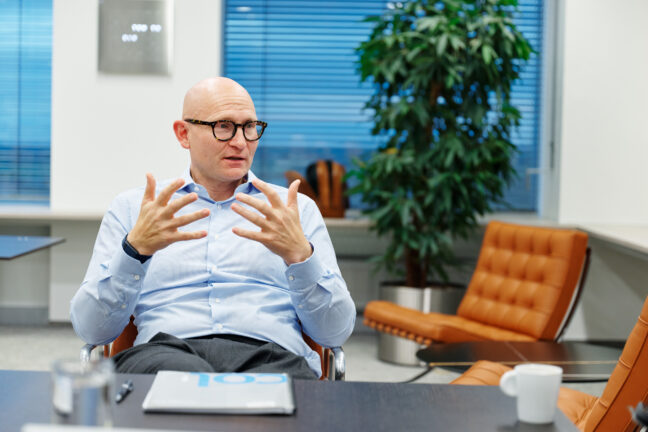Europe must update its decades-old fixed pricing rules and act as one market if it wants to guarantee a stable, sustainable supply of medicines, says Steffen Saltofte, Vice-President of Medicines for Europe and CEO of Zentiva. Among other things, this means updating decades-old rules for setting prices for medicinal products. Without reform, he cautions, Europe could lose ground to global competitors and face worsening medicine shortages.
A year ago, the Draghi report urged the EU to accelerate drug approvals, expand the use of AI, and streamline multi-country clinical trials. Yet little progress seems to have been made. How is that affecting your business in Europe?
Progress hasn’t advanced as quickly as we’d hoped. That said, there are still key developments on the table, most notably the Pharmaceutical Package currently being negotiated under the Danish presidency and the Urban Wastewater Directive, both of which are highly significant for our industry.
These are long-standing discussions, but what’s needed now is a genuine reset of priorities and stronger coordination. Europe is a single market of around 450 million people, yet decision-making remains fragmented across 27 member states.
The market is still expanding, and as a company focused mainly on generics, which account for around 70% of all medicines used in Europe, we rely heavily on regulatory and policy progress to serve patients effectively. Unfortunately, supply disruptions persist, and member states often act independently, for example through national stockpiling, which tends to favor larger countries and disadvantage smaller ones: We need stronger, more coordinated action from the European Commission to ensure affordable medicines remain accessible to all people across Europe.
One of the major new legislative initiatives is the Critical Medicines Act. What are your expectations for it?
The Critical Medicines Act is an important first step. The initial list includes 276 molecules, but that’s only the beginning. Around 90 percent of those medicines are generics, and the list will inevitably continue to grow.
However, we need to look beyond simply defining what counts as “critical” medicines. The broader ecosystem, including legislation such as the Urban Wastewater Directive, can have a direct impact on medicine supply. For example, if wastewater taxes go forward as currently proposed, products like metformin, a widely used diabetes medicine, could become too expensive to supply — in the Netherlands only the price of metformin could increase by approximately up to 900% —, which would quickly expand the list of “critical” medicines.
You might be interested
So, while the Act is a positive step forward, we need a more comprehensive approach to protect supply and maintain affordability across all medicines, not only those on a single list.

So, a broader reform of the pharmaceutical framework is needed?
Exactly. The list of critical medicines is only the starting point, but the real challenge lies in the system itself. Many European pricing regulations have remained unchanged for three decades, even as production costs rise, new taxes appear, and national policies such as stockpiling add more pressure. All of this distorts the market and weakens supply resilience.
Unless we modernize pricing and reimbursement frameworks, shortages will only deepen. And this isn’t just about critical medicines. It’s about making sure every patient in Europe can count on consistent access to affordable, high-quality treatments.
How serious are medicine shortages in Europe right now?
There is more stability in supply chains than during the COVID years, but significant challenges persist. The core problem is simple yet serious: production costs keep climbing, while prices remain frozen under outdated reimbursement systems. As a result, some medicines are no longer profitable to produce or distribute.
We are doing everything possible to maintain supply, but shortages will persist unless pricing structures are modernized to reflect today’s economic realities.
What could be done to solve this problem?
We fully share Europe’s environmental and sustainability ambitions. We’re deeply committed to the Green Deal and the goal of net-zero emissions. Our production sites are equipped with solar panels, and we’re continuously investing in more sustainable operations.
However, new measures such as wastewater taxes increase costs without offering any pricing flexibility. To put it in perspective, I have an example from the Czech Republic where we supply life-saving medicine for as little as €0.17 per dose, while a cup of coffee costs about €3. Pharmaceutical companies simply cannot adjust prices to match rising costs.
A comprehensive review of the pricing and reimbursement framework is long overdue. If Europe wants a secure, competitive, and sustainable supply of essential medicines, it must create conditions that allow manufacturers to operate responsibly and remain viable.
You’ve mentioned the Urban Wastewater Directive several times. Why is it such a concern?
The directive places full responsibility for wastewater treatment costs on pharmaceutical and cosmetics companies. Initially, the Commission estimated about €1.2 billion per year, but analyses based on national and water industry estimates suggest the real figure could be between €5 and €11 billion annually.
Of course, everyone supports the goal of clean water, and our industry is already playing its part by managing manufacturing emissions. But the system envisaged in the Directive, targeting medicine consumption, could make the production of some medicines — particularly high-volume, low-margin generics — financially unsustainable. That would lead to shortages of essential medicines such as metformin, which millions of people depend on.
We are actively engaging with EU institutions through Medicines for Europe and exploring legal avenues, because we believe the current proposal is not aligned with core EU principles. Even the Commission has acknowledged that the original cost calculations were flawed.

Pharmaceutical manufacturing does have environmental impacts. What can the industry do to minimize them?
We are constantly improving, investing in greener production technologies, greater energy efficiency, and renewable energy sources. In many areas, we are already ahead, for example by installing solar panels across our manufacturing sites.
Our industry is engaged in achieving most of Europe’s sustainability goalssuch as reducing our carbon footprint. However, regulation must strike the right balance between environmental objectives and patient access. Medicine shortages would have a far greater social and health impact than the emissions we are already working hard to reduce.
How can European-based companies compete with producers in China or India and strengthen supply security?
Over the past 10 to 15 years, many European manufacturers of active pharmaceutical ingredients (APIs) have closed, while production has shifted to China and India, which now supply roughly half of the world’s APIs. Rebuilding that capacity in Europe will take both time and significant investment.
Still, Europe retains strong manufacturing capabilities. In Prague alone, Zentiva employs almost two thousand people. European producers operate under some of the world’s most rigorous environmental and labor standards, and it is important that this commitment is properly recognized. There should be clear manufacturing and tax incentives for companies that produce and invest locally.
During the COVID pandemic, we proved that European facilities can respond rapidly to surging demand. To maintain and strengthen that resilience, we need a balanced system that supports environmental goals while ensuring economic viability. Greater flexibility in pricing, modernized procurement practices, and innovations such as digital leaflets — which would make it easier to move stock across borders — could make a real difference.
Could changes to public procurement rules help?
Public procurement can play an important role by introducing more flexibility to move products between European markets. Right now, we have 27 countries operating 27 different systems, which means that if we have surplus stock in Germany but a shortage in the Czech Republic, transferring it is far from simple.
Stronger EU-level coordination in procurement could make supply more stable and predictable. However, pricing and reimbursement frameworks also need to reflect the real costs and responsibilities that manufacturers carry.
There’s growing pressure to diversify suppliers and avoid relying on the cheapest producers. Could that help improve supply security?
Yes, definitely. Relying solely on the lowest-cost suppliers weakens long-term supply security. European manufacturers have demonstrated their ability to deliver faster, reliably, and with highest quality standards, and we have already proven that during times of crisis.
It can still take around two months for shipments to reach Europe from India or China, and they must then be re-certified before entering the market. Supporting investments by our industry in Europe would significantly reduce vulnerabilities. Member states could embed this priority in their procurement systems by rewarding security of supply criteria in procurement and in pricing policies which could help diversify the market.
Given the challenges you mentioned, is there still motivation for innovation beyond generics?
Yes, absolutely. While Zentiva’s core focus remains on generics, we continue to invest significantly in research and development. In Prague alone, around 300 specialists work on developing new value-added products and improving manufacturing processes to make medicines more accessible, sustainable, and cost-effective.
Several members of Medicines for Europe also have innovative divisions, and we all share the same goal: advancing treatment options while keeping them affordable for patients.
The EU’s next long-term budget is focused on innovation and competitiveness. How can EU-based pharmaceutical companies benefit?
The ongoing negotiations on the Pharmaceutical Package are pivotal for Europe’s pharmaceutical sector. The objective should be to accelerate access to affordable medicines once patents expire, and we fully support that direction.
At the same time, new legislation such as the Urban Wastewater Directive brings significant cost implications. Initial estimates suggested around €1.2 billion in expenses for the pharmaceutical and cosmetics industries, but industry analyses suggest the real figure could reach €10 to €12 billion. Those costs cannot be absorbed by the generic industry without significantly changing generic medicine market rules.
The EU member states should therefore take a closer look at how much of the budget is allocated to pharmaceutical procurement. That share remains surprisingly low compared to other spending priorities, even though access to medicines directly supports both public health and competitiveness.

Could increased EU R&D funding help your sector?
Certainly. We’re open to collaboration on any programs that strengthen supply and innovation in Europe. Public funding can play a vital role in supporting development and ensuring access to essential medicines. For this reason, we need the definition of innovation to include all facets of innovation including innovation in manufacturing processes for the green and digital transitions and for the security of supply.
What is the current outlook for value-added medicines?
It differs across markets, but the potential is strong. Value-added medicines, such as transforming an injectable into an oral tablet to make treatment easier, can significantly improve patient outcomes and healthcare efficiency. We can see through the EU Cancer Plan and the anticipated cardiovascular plan that value added medicines are in high demand from patients and healthcare providers. We now need a market policy that encourages investments in this affordable form of innovation. It’s an area we’re continuing to explore.
Zentiva recently announced a change in ownership. How will that affect your strategy?
Yes, Advent – our owner – announced in September the sale of Zentiva to GTCR. The transaction has not yet been completed, but we expect closing in 2026.
The new ownership fully supports Zentiva’s strategy and long-term growth ambitions. With roots dating back to 1488 and medicines reaching more than 100 million people across Europe, Zentiva is well positioned to continue growing. This step will allow us to continue investing and expanding our mission.
In 2018, you set a goal to become Europe’s leading generics producer. Has that changed?
No, that goal absolutely still stands. We have never aimed to be the biggest, but rather the best. Zentiva holds leading positions across Central and Eastern Europe and strong market positions in Western Europe, including Germany, the United Kingdom, and Italy.
Our focus remains on being the most reliable supplier of affordable, high-quality medicines for European patients. That is what true leadership means to us.
Where do you still see opportunities for growth?
Europe remains at the center of our strategy. Across more than 30 markets , there is still considerable room for growth in both Central and Western Europe. The combined generics, OTC, and specialty segments represent more than €100 billion annually and continue to grow by around 5 to 8 percent each year. We see significant opportunities to continue expanding access to affordable treatments across the region.
Finally, how do you see the future of the European pharmaceutical industry?
Europe has a strong foundation built on advanced manufacturing, skilled talent, and robust institutions. But to stay globally competitive, we need to modernize the framework that supports our industry.
Updating outdated pricing and reimbursement systems, removing unnecessary regulatory burdens, and improving cross-border flexibility would unlock tremendous potential.Europe can be both green and competitive, but only if we create a system that enables the pharmaceutical industry to grow while continuing to deliver affordable, high-quality medicines to patients.





